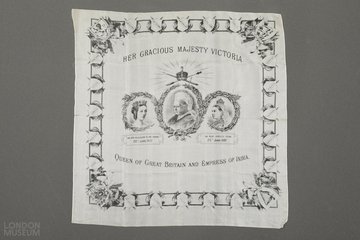
Queen Victoria's Golden Jubilee
Place of event
London and other cities in the British empire
About
Queen Victoria’s Golden Jubilee of 1887 marked a limited return to public view following her near total isolation after her husband’s death in 1861. South Asians played a prominent role in the celebrations. The Queen had assumed the title Empress of India following a controversial Royal Titles Bill in 1876; her son the Prince of Wales had visited India that same year, bringing back his mother’s Leaves from Balmoral translated into Hindustani. Shortly afterwards, the Queen began to sign correspondence 'V. R. & I.’ – Victoria Regina et Imperatrix.
On 21 June the Queen, wearing the Orders of the Garter and the Star of India, was led to Westminster Abbey by an escort of Indian cavalry under the command of Captain Charles W. Muir, Commandant of the Governor-General’s Bodyguard since 1885. Each member of the escort was later presented with a Jubilee medal by the Queen in a ceremony at Windsor Castle.
Indian princes in attendance that day included the Maharaja of Cooch Behar with his wife (significantly seen out of purdah; the state was known for its emancipated outlook); the Maharao of Kutch (aged 21 and accompanied by his brother); the Maharaja of Holkar of Indore; the Thakur of Gondal (who had studied medicine at Edinburgh and been one of the first Indian princes to receive the honour GCIE); the Thakur of Limbdi; and the Maharaja of Morvi (who made a gift of an Arab stallion with gold and silver trappings). There were also representatives from states whose rulers did not attend, including Hyderabad, Alwar, Jodpure, Bhurtapore and Kapurthala. They attended the ceremony in Westminster Abbey as well as the dinner at Buckingham Palace that night.
On 23 June the Queen received two new Indian servants: Mahomet and Abdul Karim. Karim's influence over the Queen was to raise him from waiting servant to personal teacher. As munshi, Karim later taught Victoria Hindustani and was subject of immense controversy both within the royal household and among members of the government. On 29 June at the Buckingham Palace garden party, the royal tent was attended by members of the Indian escort including Subadar Sheik Imdad Ali, a senior officer of the Viceroy’s bodyguard, and Risaldar-Major Nural Hussan of the 6th Prince of Wales Bengal Cavalry. Towards the end of July, the Indian princes who had attended the Jubilee were given a lavish farewell at Osborne on the Isle of Wight.
Royal Family, British Government.
Maharaja of Cooch Behar, Sunity Devee (Maharani of Cooch Behar), Thakur of Gondal, Abdul Karim, Maharao of Kutch, Thakur of Limbdi, Maharaja of Morvi.
Buckle, George Earle (ed.) The Letters of Queen Victoria: A Selection from Her Majesty’s Correspondence and Journal between the Years 1886 and 1901, 3 vols, (London: John Murray, 1930–2)
Chapman, Caroline and Raban, Paul (eds) Debrett’s Queen Victoria’s Jubilees 1887 and 1897, foreword by H. B. Brooks-Baker (London: Debrett’s Peerage, 1977)
Fabb, John, Victoria’s Golden Jubilee (London: Seaby, 1987)
Hibbert, Christopher, Queen Victoria: A Personal History (London: HarperCollins, 2000)
King, Greg, Twilight of Splendour: The Court of Queen Victoria during Her Diamond Jubilee Year (Hoboken, NJ: John Wiley & Sons, 2007)
Longford, Elizabeth, Queen Victoria (London: Weidenfeld & Nicolson, 1964)
Ponsonby, Sir Frederick, Recollections of Three Reigns (New York: E. P. Dutton, 1952)
Visram, Rozina, Asians in Britain: 400 Years of History (London: Pluto Press, 2002)
Newspapers from Britain and South Asia, British Library Newspapers, St Pancras
National Archives of India, New Delhi
Letters, journals, and other papers, Royal Archives, Windsor Castle, Windsor
All over the empire prisoners were released in her honour. A grateful ex-convict from Agra sent her a vast acrostic in Hindustani and English of which this was one verse:
Her Majesty’s name is Victoria, Good God!
The Indian word for Victoria is Fath
And it happens that my district is called Fathpur.
This coincidence is marvellously auspicious.
Countless telegrams from the east had to be read: ‘Empress of Hindoostan, Head of all Kings and Rulers, and King of all Kings, who is one in a Hundred, is Her Majesty Queen Victoria.’ At Mithi in Sind the authorities celebrated by opening ‘The Queen Victoria Jubilee Burial and Burning Ground'. From Madras a poem in Sanskrit welcomed railways and steamers as ‘celestial steamers’ from the queen-empress.
Elizabeth Longford, Queen Victoria (London: The Folio Society, 2007), p. 477
Image credit
Printed handkerchief, titled 'Golden Jubilee of Queen Victoria', silk, © London Museum, https://creativecommons.org/licenses/by-nc/4.0/
